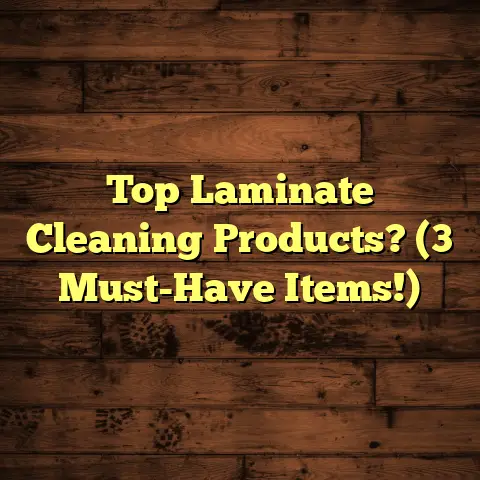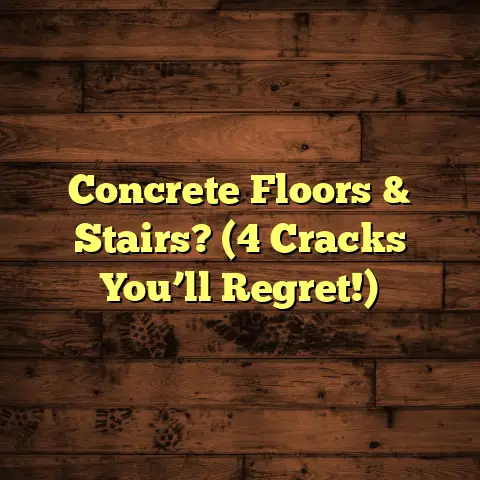Clean Tiles Without Scrubbing? (3 Pro Hacks!)
Let’s face it, nobody enjoys scrubbing tiles. It’s back-breaking work, and honestly, who has the time? But sparkling clean tiles can transform a room, making it feel fresh, inviting, and hygienic.
Think about it: that kitchen backsplash glistening in the sunlight, or the bathroom floor so clean you could (almost) eat off it. It’s not just about looks, though. Clean tiles contribute to a healthier home environment by reducing allergens and bacteria.
Now, the key to easy tile cleaning lies in understanding the surface you’re dealing with. Is it smooth and sleek, or rough and textured? Does it have a glossy sheen or a matte finish? The texture of your tiles significantly impacts how dirt and grime accumulate and, more importantly, how you should clean them.
We’ll dive into the nuances of smooth, textured, glossy, and matte tiles, and even touch on the differences between natural stone and ceramic. But the real magic is in the hacks I’m about to share.
I’m going to let you in on some secrets that I’ve learned over the years – ways to achieve that pristine tile look without spending hours on your hands and knees, scrubbing until your arms ache.
Ready to ditch the elbow grease? Let’s get started!
Section 1: Understanding Tile Textures
Okay, so before we jump into the cleaning hacks, it’s essential to understand what you’re working with. Think of your tiles like skin – each type needs a different kind of care.
1. Smooth Tiles
Smooth tiles, like polished porcelain or glazed ceramic, are generally the easiest to clean. Their non-porous surface means dirt and spills don’t penetrate easily.
However, the downside is that they can be prone to showing streaks and water spots. You know that annoying film that sometimes appears after mopping? Yeah, that’s what I’m talking about.
Cleaning Methods:
- Microfiber Mop: This is your best friend for daily maintenance. The fine fibers pick up dirt and dust without leaving streaks.
- pH-Neutral Cleaners: Avoid harsh chemicals that can dull the finish. Opt for a gentle, pH-neutral cleaner diluted in water.
- Drying is Key: After cleaning, dry the tiles with a clean, dry cloth to prevent water spots.
2. Textured Tiles
Textured tiles, like slate or some types of porcelain, offer a unique aesthetic appeal, but they can be a pain to clean. The grooves and ridges trap dirt, grime, and even mold, making traditional scrubbing methods less effective.
Imagine trying to scrub a waffle iron with a flat sponge – you’re only hitting the high points. That’s what it’s like cleaning textured tiles with the wrong approach.
Cleaning Considerations:
- Penetrating Cleaners: You need a cleaning solution that can penetrate the texture and loosen the dirt.
- Avoid Abrasives: Scrubbing with harsh abrasives can damage the tile and make the texture even more pronounced.
- Specialized Brushes: Consider using a brush with stiff, but flexible bristles to reach into the grooves.
3. Glossy vs. Matte Finishes
Glossy and matte finishes present different cleaning challenges. Glossy tiles, as we discussed, are prone to streaks. They reflect light, so any imperfections are easily visible.
Matte tiles, on the other hand, tend to hide dirt better, but they can require more effort to clean because they often have a slightly rougher surface.
Cleaning Product Choices:
- Glossy Tiles: Look for cleaners specifically formulated for glossy surfaces. These often contain ingredients that help prevent streaking.
- Matte Tiles: A slightly more alkaline cleaner might be necessary to cut through the grime. Always test in an inconspicuous area first.
4. Natural Stone vs. Ceramic Tiles
Natural stone tiles, like marble, granite, and travertine, are porous, meaning they can absorb liquids and stains. They require special care and cleaning products specifically designed for natural stone.
Ceramic tiles, on the other hand, are generally more forgiving. They’re less porous and more resistant to stains, making them easier to maintain.
Special Considerations:
- Natural Stone: Seal regularly to prevent staining. Avoid acidic cleaners like vinegar, as they can etch the surface.
- Ceramic Tiles: While more durable, ceramic tiles can still be damaged by harsh chemicals. Stick to pH-neutral cleaners.
Here is a quick comparison table:
| Tile Type | Texture | Cleaning Challenges | Recommended Cleaning |
|---|---|---|---|
| Smooth Tiles | Smooth | Streaks, water spots | Microfiber mop, pH-neutral cleaner, drying after cleaning |
| Textured Tiles | Rough/Uneven | Trapped dirt, mold | Penetrating cleaners, specialized brushes, avoid abrasives |
| Glossy Tiles | Smooth & Reflective | Streaks | Cleaners for glossy surfaces, drying after cleaning |
| Matte Tiles | Slightly Rough | Can require more effort | Slightly alkaline cleaner, test first |
| Natural Stone | Porous | Staining, etching | Stone-specific cleaners, regular sealing, avoid acids |
| Ceramic Tiles | Non-Porous | Generally easy to clean | pH-neutral cleaners |
Understanding these differences is crucial for choosing the right cleaning approach. Now that we’ve covered the basics, let’s move on to the hacks!
Section 2: Pro Hack #1 – Vinegar and Baking Soda
Alright, let’s dive into our first pro hack: the dynamic duo of vinegar and baking soda. This is a classic combination for a reason – it’s natural, effective, and you probably already have these ingredients in your pantry.
1. Chemical Interaction
The magic behind this hack lies in the chemical reaction between vinegar (an acid) and baking soda (a base). When combined, they create carbon dioxide gas, which helps to lift dirt and grime from the tile surface.
Think of it like a gentle bubbling action that dislodges stubborn stains without the need for harsh scrubbing.
2. Application Method
Here’s how to apply this method effectively, depending on your tile texture:
For Smooth Tiles:
- Mix: Combine equal parts white vinegar and water in a spray bottle.
- Spray: Lightly spray the solution onto the tile surface.
- Sprinkle: Dust a thin layer of baking soda over the sprayed area.
- Fizz: Let the mixture fizz for about 5-10 minutes.
- Wipe: Wipe away the residue with a damp microfiber cloth.
- Dry: Dry the tiles with a clean, dry cloth to prevent water spots.
For Textured Tiles:
- Paste: Create a paste by mixing baking soda with just enough vinegar to form a thick consistency.
- Apply: Apply the paste to the textured areas, making sure to get into the grooves.
- Dwell: Let the paste sit for 15-20 minutes to allow the cleaning action to penetrate.
- Scrub (Gently): Use a soft-bristled brush to gently scrub the paste into the texture.
- Rinse: Rinse thoroughly with clean water.
- Dry: Dry the tiles with a clean cloth.
Pro Tip: For heavily soiled areas, you can let the paste sit overnight before scrubbing.
3. Safety Considerations
While vinegar and baking soda are generally safe, it’s always a good idea to test this method on a small, inconspicuous area first, especially if you have delicate tiles like natural stone.
Also, avoid using this method on grout that has been recently sealed, as the vinegar can break down the sealant.
4. Effectiveness
I’ve personally used this hack on countless projects, and I’m always impressed with the results. I remember one client who had heavily soiled ceramic tiles in their kitchen. They had tried everything, but nothing seemed to work.
I suggested the vinegar and baking soda method, and they were amazed at how easily the dirt lifted away. They said it was like magic!
I’ve seen similar results with textured porcelain tiles in bathrooms. The paste effectively loosens the grime that gets trapped in the grooves, leaving the tiles looking fresh and clean.
One thing to note is that while this method is effective for general cleaning, it may not be strong enough for stubborn stains like grease or mildew. But for everyday dirt and grime, it’s a fantastic option.
Section 3: Pro Hack #2 – Steam Cleaning
Now, let’s move on to our second pro hack: steam cleaning. This is a game-changer for tile cleaning because it uses the power of steam to disinfect and lift dirt without the need for harsh chemicals or vigorous scrubbing.
1. How Steam Cleaning Works
Steam cleaning works by using high-temperature steam to loosen dirt, grease, and bacteria from the tile surface. The heat and moisture penetrate the pores of the tile and grout, effectively dislodging even stubborn grime.
Plus, the high temperature of the steam kills bacteria, mold, and other microorganisms, making it a great option for sanitizing your tiles.
2. Using the Right Equipment
There are several types of steam cleaners available, ranging from handheld units to canister models. For tile cleaning, I recommend using a steam cleaner with a floor attachment and a grout brush.
- Handheld Steam Cleaners: These are great for small areas and spot cleaning.
- Canister Steam Cleaners: These offer more power and capacity, making them ideal for larger areas.
- Steam Mops: These are specifically designed for floor cleaning and are easy to use.
When choosing a steam cleaner, look for one with adjustable steam settings and a variety of attachments to suit different tile textures.
3. Techniques for Different Tiles
Here are some tips on how to use steam cleaning effectively on different textured tiles:
- Smooth Tiles: Use the floor attachment with a microfiber pad. Move the steam cleaner in overlapping strokes to ensure even coverage.
- Textured Tiles: Use the grout brush attachment to target the grooves and ridges. Move the brush back and forth to loosen the dirt.
- Glossy Tiles: Use a low steam setting to prevent streaking. Dry the tiles with a clean cloth after steam cleaning.
- Natural Stone: Use a low steam setting and avoid prolonged exposure to heat. Seal the stone regularly to protect it from moisture.
4. Advantages Over Traditional Methods
Steam cleaning offers several advantages over traditional cleaning methods:
- Reduced Chemical Use: Steam cleaning uses only water, eliminating the need for harsh chemicals.
- Faster Drying Times: Steam evaporates quickly, reducing drying times.
- Sanitizing: Steam kills bacteria, mold, and other microorganisms.
- Eco-Friendly: Steam cleaning is a sustainable and environmentally friendly cleaning option.
I’ve been using steam cleaners for years, and I’ve seen firsthand the amazing results they can achieve. One of my favorite experiences was cleaning a heavily soiled bathroom with textured ceramic tiles.
The steam cleaner effortlessly lifted years of built-up grime, leaving the tiles looking brand new. The client was so impressed that they immediately went out and bought their own steam cleaner!
Steam cleaning is a fantastic option for anyone looking for a safe, effective, and eco-friendly way to clean their tiles.
Section 4: Pro Hack #3 – Commercial Tile Cleaners
Okay, let’s move on to our final pro hack: commercial tile cleaners. While I love natural cleaning methods, sometimes you need a little extra power to tackle tough stains and grime.
1. Understanding the Ingredients
Commercial tile cleaners come in a variety of formulations, each designed to address specific cleaning challenges. Here are some common types:
- Enzymatic Cleaners: These contain enzymes that break down organic matter, such as food spills and pet stains.
- Oxygen Bleach Cleaners: These use the power of oxygen to lift stains and brighten tiles.
- Non-Toxic Cleaners: These are formulated with plant-based ingredients and are safe for use around children and pets.
When choosing a commercial tile cleaner, it’s important to consider the type of tile you have and the specific cleaning challenges you’re facing.
2. Application Tips
Here are some tips on how to use commercial tile cleaners effectively:
- Read the Label: Always read and follow the manufacturer’s instructions.
- Dilute: Dilute the cleaner according to the instructions. Using too much cleaner can leave a residue on the tile surface.
- Apply: Apply the cleaner to the tile surface using a spray bottle or a mop.
- Dwell Time: Allow the cleaner to dwell on the surface for the recommended time. This allows the cleaning agents to penetrate the dirt and grime.
- Rinse: Rinse thoroughly with clean water.
- Dry: Dry the tiles with a clean cloth.
Pro Tip: For heavily soiled areas, you can use a scrub brush to agitate the cleaner and loosen the dirt.
3. Comparing Products
Here are a few popular commercial tile cleaners and their unique features:
| Product | Type | Key Features |
|---|---|---|
| Bona Stone, Tile & Laminate Cleaner | Non-Toxic | pH-neutral, streak-free formula, safe for all types of tile |
| Zep Tile & Grout Cleaner | Alkaline | Powerful degreaser, removes tough stains, ideal for grout cleaning |
| CLR Mold & Mildew Stain Remover | Bleach-Based | Kills mold and mildew, removes stains, use in well-ventilated areas |
4. User Experiences
I’ve had great success using commercial tile cleaners on various projects. One that always sticks out is when I was dealing with a client who had years of built-up grease and grime on their kitchen tiles.
I tried several natural cleaning methods, but nothing seemed to work. Finally, I decided to try Zep Tile & Grout Cleaner, and I was amazed at how easily it cut through the grease. The tiles looked brand new!
Another time, I used Bona Stone, Tile & Laminate Cleaner on a client’s delicate marble tiles. I was impressed with how gentle and effective it was. The tiles were left sparkling clean without any damage.
Commercial tile cleaners can be a great option for tackling tough cleaning challenges. Just be sure to choose the right product for your tile type and always follow the manufacturer’s instructions.
Conclusion
So, there you have it – three pro hacks for cleaning tiles without scrubbing! We’ve covered the power of vinegar and baking soda, the magic of steam cleaning, and the effectiveness of commercial tile cleaners.
Remember, the key to easy tile cleaning is understanding the texture of your tiles and choosing the right cleaning method for the job.
Don’t be afraid to experiment with these methods and find what works best for you. With a little knowledge and the right tools, you can achieve a cleaner, more inviting home environment with minimal effort.
Now, I’d love to hear from you! Have you tried any of these hacks? Do you have any additional tips to share? Let me know in the comments below! And if you found this article helpful, please share it with your friends and family.
Happy cleaning!





